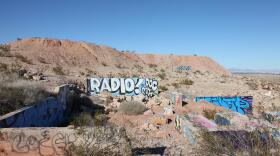Thirty years ago, the Pepcon explosion shook the valley — and revealed a different kind of fracture
Thick black and rust-colored smoke filled the sky above the southeast Las Vegas Valley shortly before noon on May 4, 1988. A series of thunderous explosions echoed. The ground shook and concussion waves shattered windows, caved in walls, and knocked cars off roads for miles around.
Near what is now Wigwam Parkway and Gibson Road, the Pacific Engineering & Production Company (Pepcon) solid-rocket-fuel component plant and adjacent Kidd Marshmallow facility were destroyed. The blasts killed two Pepcon workers, injured more than 300, and caused losses in excess of $80 million.
“It knocked everybody within 300 yards off their feet,” Bob Hampton, Pepcon’s manager of design and drafting, told the Henderson Home News that day. Hampton said he was behind a car when an explosion shattered its windows and cut up his face.
Pepcon and nearby Kerr-McGee were the nation’s only producers of ammonium perchlorate, used in rockets for the space shuttle and the Department of Defense. The Clark County Fire Department concluded that a spark from a welder’s torch caused a fire, which spread to stored ammonium perchlorate, igniting the explosions.
In the months afterward, Pepcon and the industrial area it was part of became a symbol of a clash between new and old in Henderson. Green Valley, the area’s first master-planned community, was blooming west of the plants. Under the spell of a pervasive marketing campaign, many of its residents did not identify themselves as part of Henderson. A swath of empty desert between the new neighborhoods and the city’s core perpetuated the mindset.
Residents in older neighborhoods east of the plants understood the city’s very existence stemmed from the industries, built to supply material for World War II. Those whose livelihoods still depended on them clung to a hardscrabble identity.
Former Clark County Commissioner Bruce Woodbury attended a meeting with hundreds of residents shortly after the explosions. “Just as adamant and passionate as the Green Valley people were the union members and the families and a lot of the old-time residents in the area and closer to the plants, (saying) basically, ‘Look, we were here first, so deal with it.’” Woodbury tried to assure residents “that we were going to do whatever we can to make everybody safe. But I certainly did not commit to making anything go away.”
Clark County Commissioner Jim Gibson, whose grandfather cofounded Pepcon and whose uncle was then its CEO, says the event represented a personal, economic, and political thicket for his family.
“We heard complaints and worries and concerns ...” Gibson says. “What was our housekeeping like? What were our procedures and processes like? But we feel like we answered those questions and stepped up in every material way you could.” Understanding that residences were encroaching on the site, Pepcon rebuilt outside Cedar City, Utah, and was manufacturing ammonium perchlorate again by 1989.
“We didn’t want to relocate. None of the executives in the company, except the plant manager, moved. They stayed in the corporate offices here, and we continued to be a Nevada company,” says Gibson, who served as Henderson’s mayor from 1997 to 2009.
Woodbury served on the Governor’s Blue Ribbon Commission to examine laws regulating highly combustible materials. It produced 43 recommendations on air, land, and water quality; chemical storage and transportation; and more. The Legislature in 1991 approved the Chemical Catastrophe Prevention Act, which established a list of hazardous materials and limited onsite storage.
Amid the heightened attention on the industrial area and environmental cleanup, Henderson was among the fastest-growing regions in the country during the 1990s. “The growth was relentless in those days,” Woodbury says. “Developers and businesses were looking for any available land to put their projects on, and those regulations would have helped in regard to the safety of any such development.”
Within five years, Henderson hit the 100,000 population mark, which encouraged more growth, including the opening of the Galleria at Sunset mall in 1996. The expansion of Interstate 215 tightened the psychological and physical gap between east and west, old and new.
Thirty years later, the Pepcon site is a thriving business park, with nary a sign of the frightening explosions. Commercial and residential areas fill the formerly empty land, concealing the scars of one of the most difficult days in the valley’s history.







